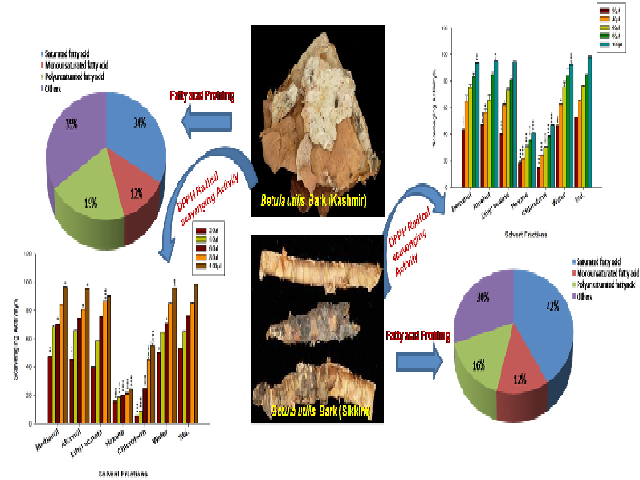Comparative Analysis of Fatty Acids and Antioxidant Activity of Betula utilis Bark Collected from Different Geographical Region of India
DOI:
https://doi.org/10.5530/fra.2017.1.12Keywords:
Betula utilis, Free radicals, Antioxidant, Total phenol, FlavonoidAbstract
Objective: The present study investigated the comparative analysis of fatty acid and antioxidant activity from the bark of Betula utilis, collected from Kashmir and Sikkim coded as BUK and BUS respectively. Methods: Fatty acid constituents were analyzed by GCMS (gas chromatography mass spectroscopy) in BUK and BUS bark. B. utilis bark extracts of both the locations were phytochemically investigated and radical scavenging activity was evaluated by DPPH in all solvent fractions. Results: Phenolic content were found to be higher in methanolic extracts of BUK bark, 5.8 ± 0.1 mg/gm and flavonoid content were higher in the water extract of BUK bark, 6.16 ± 0.2 mg/gm. The radical scavenging activity was found to be higher methanolic, alcoholic and water extracts of BUK bark. The lowest IC50 value for radical scavenging activity of methanolic and water extracts of B. utilis bark collected from Kashmir were found 18.7 ± 1.1 and 18.2 ± 0.3 μg/mL, respectively. Thirteen fatty acids were identified in the sample BUK as well as BUS in which the major fatty acids were found-Palmitic acid, linoleic acid and oleic acid. BUK possess the highest amount of Palmitic acid (18.07%) in oily portion of the bark. Conclusion: The present study concluded that BUK and BUS extracts have shown significant antioxidant activity in comparison to standard but BUK possess potent radical scavenging activity over BUS, and higher amounts palmitic acid, linoleic acid and oleic acid was present in the extract, and may a play an important role in nutritional and pharmaceutical applications.
Downloads
Metrics





